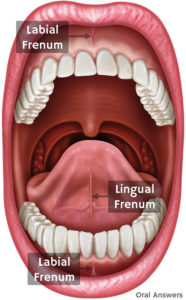 Great Smiles Start Early!
Great Smiles Start Early!
If you are not sleeping, breathing and/or chewing well, it’s physically impossible to be optimally healthy! No matter what your age, you can work on retraining your oral-facial and neck muscles to help you achieve better sleep, as well as proper breathing and digestion.
Myofunctional therapy is a highly effective, painless way to activate proper alignment and function of the facial muscles. It is a program of exercises that help restore strength and coordination, retraining muscles of the face and tongue to optimize complex functions such as breathing, chewing, swallowing, speaking, occlusion, temporomandibular joint movement, oxygen flow to vital organs, oral hygiene, stability of orthodontic treatment, facial esthetics, and facial skeletal growth. Orofacial Myofunctional Therapy (OMT) instills positive habits to ensure those changes last a lifetime.
At Gorman Health and Wellness, our oral healthcare specialist and licensed dental hygienist—Melina—is trained in myofunctional therapy, enabling her to properly diagnose poor oral habits/function and custom-tailor treatment plans to meet the unique needs and goals of each patient for optimal results. If you are interested in myofunctional therapy for yourself or a loved one, we encourage you to learn more by reading the detailed information provided on this page, or simply contact our practice today to schedule a consultation.
What Are the Benefits of Myofunctional Therapy?
Poor oral behaviors, also known as orofacial myofunctional disorders (OMDs), have been found to be the main cause of most orthodontic issues and various health concerns. OMDs can include improper swallowing, breathing through the mouth, thumb sucking, and more. Through special myofunctional therapy exercises and treatment plans, the root of these concerns (e.g., misaligned teeth, crowding, and improper jaw development) can be addressed and corrected.
Patients who have undergone myofunctional therapy have regained enjoyment of eating, breathing, speaking, and even sleeping more soundly. We also see many patients who suffer from TMJ Dysfunction or Obstructive Sleep Apnea who have found improvement in symptoms after therapy. As an added benefit, when the muscles tighten, the face often looks better, younger, and lifted without injections or surgery. In fact, it has been reported that many plastic surgeons in Brazil work with orofacial myotherapists to get the best cosmetic results for their patients.
Myofunctional Therapy vs. Orthodontics
Traditional orthodontic treatment typically involves waiting until all permanent teeth have grown in, and uses tooth extractions and braces to straighten teeth and realign the jaw. Although this approach is generally the most effective way to straighten teeth, it does not address the underlying cause(s) of orthodontic issues, which means most results will not be permanent without the help of retainers. Conversely, myofunctional therapy is designed to pinpoint and correct these behaviors, even in young children whose jaws and teeth are still developing.
Who Needs Myofunctional Therapy?
- Is your child a picky eater?
- Do you have chronic jaw pain?
- Are you frustrated that speech therapy has not fixed the problem?
- Has your child been diagnosed with a disorder such as Apraxia?
- Has your dentist pointed out an overbite caused by “tongue thrust”?
- Does your infant have difficulty feeding?
Children and adults with orofacial myofunctional disorders may struggle with:
- Mouth breathing
- Bottle feeding
- Thumb, finger, & pacifier sucking
- Long Face Syndrome
- Tongue thrusting
- Tongue Tie
- Reverse swallow
- Lisping / speech issues
- Poor posture / leaning on chin
- Cheek or lip biting
- Lips not remaining sealed
- Picky/messy eating
- Choking when eating
- Snoring/sleep issues
- Crowded teeth
- Grinding, clenching, bruxism
- Nasal congestion
- Allergies
- Jaw pain
- Headaches
- Orthodontic relapse
Why Choose Gorman Health and Wellness for Myofunctional Therapy?
Myofunctional therapy at Gorman Health and Wellness is conducted by our extensively trained myofunctional therapist, Melina. To complete her training, Melina underwent a rigorous program in which she obtained a comprehensive understanding of orofacial growth, anatomy, and function while learning various methods for resolving related issues. She is also a licensed dental hygienist, making her uniquely qualified to properly examine the mouth, diagnose oral dysfunction / poor oral habits, and personalize the most effective myofunctional therapy plan based on each individual’s particular case.
For patients who do not live near the Encino area, Melina can hold virtual Skype sessions throughout the course of therapy, making treatment more convenient and accessible. In addition, for individuals suffering from sleep apnea and/or snoring, she also works closely with Dr. Martin Gorman—our experienced dentist and a leading doctor in the breathing wellness movement. This special collaboration has led to exceptional, life-improving results for numerous patients experiencing sleep-related airway conditions and their many detrimental side effects.
What is the Myofunctional Therapy Process Like?
In your consultation, Melina can create a personalized treatment plan based on your—or your child’s—unique needs. Myofunctional therapy consists of specific oral and facial exercises designed to address the improper myofunctional habits that cause orthodontic and/or breathing issues. Patients will be asked to perform these exercises regularly to help develop healthier habits and realign the jaw muscles, ultimately aiding in the ability to maintain optimal oral posture, breathe through the nose, swallow properly, and more. In some cases, an oral appliance may be required to help train the tongue and jaw. Additionally, certain patients may need braces for a short period of time after myofunctional therapy has been completed.
During the span of treatment, periodic “check-in” visits are typically scheduled with Melina to ensure everything is progressing as planned. For those who do not live locally, she can conduct these appointments via Skype.
How Long Does Myofunctional Therapy Take?
The entire myofunctional therapy process generally takes about six months to complete for most patients, though the exact amount of time depends on the severity of issues, as well as the patient’s commitment to performing the exercises as directed (for young patients, this also includes parent participation to ensure their child completes the exercises).
Functional Frenectomy
 In some cases, orofacial dysfunction is the result of constraints caused by frenum, muscular attachments in the mouth found between the gums and lips, as well as beneath the tongue. The two types of frenum, characterized as labial and lingual, can result in a range of physiological symptoms that affect a patient’s quality of life.
In some cases, orofacial dysfunction is the result of constraints caused by frenum, muscular attachments in the mouth found between the gums and lips, as well as beneath the tongue. The two types of frenum, characterized as labial and lingual, can result in a range of physiological symptoms that affect a patient’s quality of life.
The superior labial frenulum is the strip of muscle that extends between the center of the gums and the two front teeth to the inside of the top lip (similarly, the inferior labial frenulum connects the lower lip to the gums). The lingual frenulum is found where the tongue meets the floor of the mouth. These oral soft tissues contain many tiny fibers that extend all the way to the chest and spine, creating an impact on other structures of the body that may not be entirely obvious. If the frenum are too restrictive, common symptoms include large gaps between the two front teeth, gum recession, problems when eating and speaking, and even shoulder and neck pain.
To address these concerns, a frenectomy can be performed to release the muscular attachment(s) from the gums. This simple procedure is utilized in a number of circumstances, including:
- When the lingual frenulum is inhibiting proper eating or speaking function
- In the event that oral restrictions are causing discomfort, pain, or tension
- When optimal orofacial function is inhibited by a restrictive frenulum
Dr. Gorman offers functional frenectomy as an in-office procedure and can perform a thorough examination to identify whether frenal restraint is the cause of your symptoms. Many patients notice a variety of physiological improvements after a frenectomy, such as relaxed shoulders, improved posture, easier breathing, and enhanced biting function, among other advancements. However, undergoing myofunctional therapy before and after a functional frenectomy is imperative to the success of the procedure in effectively repatterning the behavior of the tongue and lips for long-lasting results. With this comprehensive approach—considered an osteopathically-guided functional frenectomy—patients can restore the full integrity of their orofacial structures, recover their physiological wellness, and improve their quality of life.
Contact Us
If you think you or your child may be able to benefit from myofunctional therapy, please do not hesitate to contact our office today to schedule a consultation at Gorman Health and Wellness.